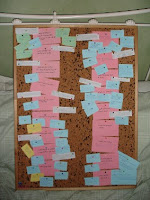Okay, a little bit more about the plot board! I use it to
pin ideas on in the planning stages, to help with restructuring and editing in
the revision stages, and just generally to help me to think through my book in
a visual way when I need it.
Before I blog about how I’m using it on my current book, I
might as well explain how I lay it out, otherwise none of it is going to make
sense!
If I could have one very, very long board so I could see the
whole of my story in one line, I would, but since they don’t make cork boards
that shape, I have to make do with splitting the story up into four sections: Act 1,Act 2: split into two parts – a & b,Act 3.
I don’t think there are any set rules when it comes to story
structure. Some story gurus split the story into three acts, others split it
into four. There are different terms to for different parts of a story,
depending on who you read or who you listen to, but most tend to outline the same basics elements
of a story; they just have different ways of describing it. My advice is to go
with what works makes sense to you; I’m just going to share what fits my
personal process the best.
As I mentioned in my last post, I like the way Michael Hauge
splits up a story: three acts, with a turning point between each, and then
turning points in the middle of each act. Now, this can sound a bit artificial –
and some of you reading this may be breaking out in hives at the thought of all
this scary structure! – but even before I knew any of this, my stories tended
to hit these breaks and turning points. I think it’s because stories that work
tend to have a certain rhythm, certain rises and falls in tension, twists and
turns in direction to keep them interesting. Quite often I don't plan what's going to be a turning point, but it becomes obvious as the story evolves.
If you look at my empty plot board pic, you can see I have some headings in yellow and these are my stages/turning points. I’ll outline them here and then over the next few posts I’m going to go into more detail:
Act 1
Section 1: Ordinary
world
Turning point 1:
The call to adventure
Section 2: Debate
& denial
Turning point 2: Change
of plans
Act 2
Section 3: Progress
(Fun & Games)
Turning point 3: Point
of no return
Section 4: Complications
& Higher Stakes (Bad guys close in)
Turning point 4: Black
moment
Act 3:
Section 5: Final
push (Dark night of the soul/Solution)
Turning point 5: Climax
Section 6: New
world (Aftermath)
Next time, we'll break down Act One...
Next time, we'll break down Act One...






